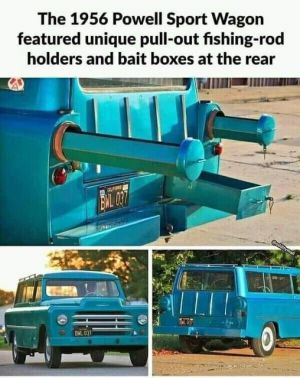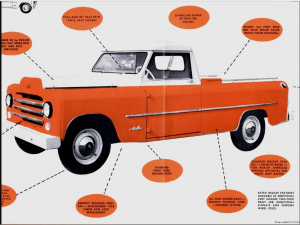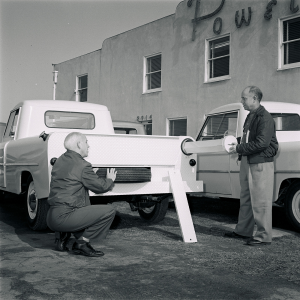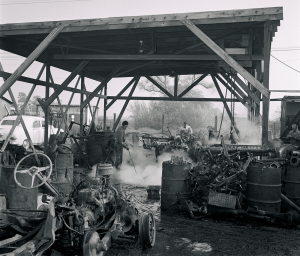Difference between revisions of "Powell Sport Wagon"
Old Hippie (talk | contribs) |
Old Hippie (talk | contribs) |
||
| (3 intermediate revisions by the same user not shown) | |||
| Line 4: | Line 4: | ||
In the mid-1950s, America's lofty goals were not yet to put a man on the moon, but for a good twenty-five cent cigar and a new car for under $1,000 - which is about $11,300 in 2023 money (#LGB). Brothers Channing and Hayward Powell would build what they advertised as "America’s 1st car produced to sell below $1000.” | In the mid-1950s, America's lofty goals were not yet to put a man on the moon, but for a good twenty-five cent cigar and a new car for under $1,000 - which is about $11,300 in 2023 money (#LGB). Brothers Channing and Hayward Powell would build what they advertised as "America’s 1st car produced to sell below $1000.” | ||
| − | Their company Powell Manufacturing Company, | + | Their company Powell Manufacturing Company (PMC) of Compton, CA started manufacturing radios in 1928, but quickly moved on to building scooters and minibikes. In 1954, they started building 1955 model [[Pickup trucks]]. |
| − | Their unique way of achieving that goal was to buy junked 1940-1941 [[Plymouth]] [[Chassis]] and refurbish. On that, they would place a [[Pickup truck]] or a [[SUV]] body they fabricated with a fiberglass [[front clip]] | + | Their unique way of achieving that under $1000 goal was to buy junked 1940-1941 [[Plymouth]] [[Chassis]] and refurbish. Later they would also use Dodge Chassis. They'd buy the cars and discard the bodies. On that, they would place a [[Pickup truck]] or a [[SUV]] "Sport Wagon" body they fabricated with a [[fiberglass]] [[front clip]]. The [[cab]] rearward was simple design without complex curves so it could be quickly made without [[stamping dies]]. One of the most unique features were the Fishing Pole Storage, which pulled out from the rear of the truck. While no records remain of the company, approximately 1,030 pickups, 300 (beginning in late 1956) Sport Wagons and three [[motorhomes]] were built. Less than 150 are thought to still survive. The engines were mostly Plymouth 202ci Sixes, however some were built with Dodge and Chrysler Industrial engines. They started out with Oak bumpers, until deemed unsafe, then switched to metal. Diamond Plate bumpers were an option. The chrome strips on the grill were actually rear side trim from the rear fender of a 50 Ford Sedan |
| − | |||
| − | + | Powell's Pickup Truck & SUV manufacturing only lasted from (started Production of the 1955 models in 1954) 1955 until early 1957. The company returned to building Scooters and mini-bikes in 1960. The reason the Powell Pickups and Sport Wagons make it into the MoparWiki, is it's Mopar [[Drivetrain]]s. | |
| − | + | <!-- The below are the photos that line up on the right side. Use the Upload link to upload photos of this car model and replace the uploaded image name and the photo's description in the below. Again, more information is in the understanding wikis title in the sidebar --> | |
| − | + | [[Image:Powell.jpg|thumb|300px|1956 Powell Pickup]] | |
| + | [[Image:Powell1.png|thumb|300px|Early Pickup Brochure]] | ||
| + | [[Image:Powell2.png|thumb|300px|Early Pickup Brochure]] | ||
| + | [[Image:Powell3.png|thumb|300px|Fishing Pole Storage & Diamondplate read bumper]] | ||
| + | [[Image:Powell4.png|thumb|300px|Disassembling and steam cleaning what will be used from Junk Plymouths]] | ||
| + | [[Image:Powell5.png|thumb|300px|Assembly Line. Note the Fiberglass front clip]] | ||
| − | |||
| − | |||
| − | |||
| − | |||
| − | |||
| − | |||
| − | |||
| − | |||
| − | |||
| − | |||
| − | |||
| + | === Direct Competition === <!-- as Maverick and Nova was to Duster --> | ||
| − | + | [[Jeep]] | |
| − | |||
| − | |||
| − | |||
| − | |||
| − | |||
| − | |||
| − | |||
| − | |||
== Technical == <!-- Do not remove this line as it is a heading --> | == Technical == <!-- Do not remove this line as it is a heading --> | ||
| Line 48: | Line 34: | ||
=== Platform === <!-- A-Body, B-Body,... --> | === Platform === <!-- A-Body, B-Body,... --> | ||
| − | + | The platform was from Salvage parts from 1940 and 1941 Plymouths which were cleaned refurbished and painted. | |
=== Available Engines === <!-- list CID/HP and years offered --> | === Available Engines === <!-- list CID/HP and years offered --> | ||
| − | Refurbished Plymouth, [[Dodge]] and [[Chrysler]] [[Sixes]]. | + | Refurbished Plymouth, [[Dodge]] and [[Chrysler]] [[Industrial]] [[Sixes]]. |
=== Available Transmissions === <!-- list transmissions offered --> | === Available Transmissions === <!-- list transmissions offered --> | ||
| Line 69: | Line 55: | ||
=== Wheelbase === <!-- list wheelbases and year range for each --> | === Wheelbase === <!-- list wheelbases and year range for each --> | ||
| + | |||
117" | 117" | ||
| Line 74: | Line 61: | ||
=== Curb Weight === | === Curb Weight === | ||
| + | |||
| + | 2700 pounds | ||
== Famous Examples of This Model == <!-- Do not remove this Heading --> | == Famous Examples of This Model == <!-- Do not remove this Heading --> | ||
| Line 88: | Line 77: | ||
== References == <!-- do not remove this heading --> | == References == <!-- do not remove this heading --> | ||
| − | |||
=== Books & [[Magazine References]] === <!-- list all printed material you got you facts from --> | === Books & [[Magazine References]] === <!-- list all printed material you got you facts from --> | ||
| Line 108: | Line 96: | ||
[[Category:Powell|Sport Wagon]] | [[Category:Powell|Sport Wagon]] | ||
[[Category:Powell|Pickup]] | [[Category:Powell|Pickup]] | ||
| + | [[Category:Make|Powell]] | ||
[[Category:Under Construction]] <!-- Remove from this category once Wiki is more than 75% complete --> | [[Category:Under Construction]] <!-- Remove from this category once Wiki is more than 75% complete --> | ||
[[Category:Needs Photos]] <!-- Remove from this category once Wiki an adequate number of photo with relation to its size --> | [[Category:Needs Photos]] <!-- Remove from this category once Wiki an adequate number of photo with relation to its size --> | ||
Latest revision as of 03:03, 24 May 2023
In the mid-1950s, America's lofty goals were not yet to put a man on the moon, but for a good twenty-five cent cigar and a new car for under $1,000 - which is about $11,300 in 2023 money (#LGB). Brothers Channing and Hayward Powell would build what they advertised as "America’s 1st car produced to sell below $1000.”
Their company Powell Manufacturing Company (PMC) of Compton, CA started manufacturing radios in 1928, but quickly moved on to building scooters and minibikes. In 1954, they started building 1955 model Pickup trucks.
Their unique way of achieving that under $1000 goal was to buy junked 1940-1941 Plymouth Chassis and refurbish. Later they would also use Dodge Chassis. They'd buy the cars and discard the bodies. On that, they would place a Pickup truck or a SUV "Sport Wagon" body they fabricated with a fiberglass front clip. The cab rearward was simple design without complex curves so it could be quickly made without stamping dies. One of the most unique features were the Fishing Pole Storage, which pulled out from the rear of the truck. While no records remain of the company, approximately 1,030 pickups, 300 (beginning in late 1956) Sport Wagons and three motorhomes were built. Less than 150 are thought to still survive. The engines were mostly Plymouth 202ci Sixes, however some were built with Dodge and Chrysler Industrial engines. They started out with Oak bumpers, until deemed unsafe, then switched to metal. Diamond Plate bumpers were an option. The chrome strips on the grill were actually rear side trim from the rear fender of a 50 Ford Sedan
Powell's Pickup Truck & SUV manufacturing only lasted from (started Production of the 1955 models in 1954) 1955 until early 1957. The company returned to building Scooters and mini-bikes in 1960. The reason the Powell Pickups and Sport Wagons make it into the MoparWiki, is it's Mopar Drivetrains.
Contents
Direct Competition
Technical
Price Class
Goal was to be priced under $1,000
Platform
The platform was from Salvage parts from 1940 and 1941 Plymouths which were cleaned refurbished and painted.
Available Engines
Refurbished Plymouth, Dodge and Chrysler Industrial Sixes.
Available Transmissions
Refurbished Mopar 3-speed manual transmission
Overall Length
168"
Overall Width
72"
Height
Wheelbase
117"
Front/Rear Track
Curb Weight
2700 pounds
Famous Examples of This Model
Movies
TV Series
Racing
Owner/Driver Impressions
Name of Reviewer
References
Books & Magazine References
Internet
- MoparWeb.com
- Hand Eye Supply
- Makes That Didn't Make it
- Petersen
- Powell Sport Wagon Registry
- Hemmings
Random Page | Longest Wikis | Oldest Wikis | Newest Images | Newest Wikis | List of Categories | List of Every Freakin Wiki
- Register to Edit
- It takes less than 5 minutes to request registration for editing, and we try to approve within 24 hours. Click the Register Link in the Top Bar.
- MoparWiki Help
- While editing Wikis may at first glance appear a little overwhelming, it really isn't. You will find this site's HELP (link found in the sidebar) to be very strong and easy to understand. The best way to start is with small edits and working on your user page -- and you will become a Pro in no time.
Change the Category below the Comments to the appropriate category(s). In the special pages you will find a link to the list of categories.







